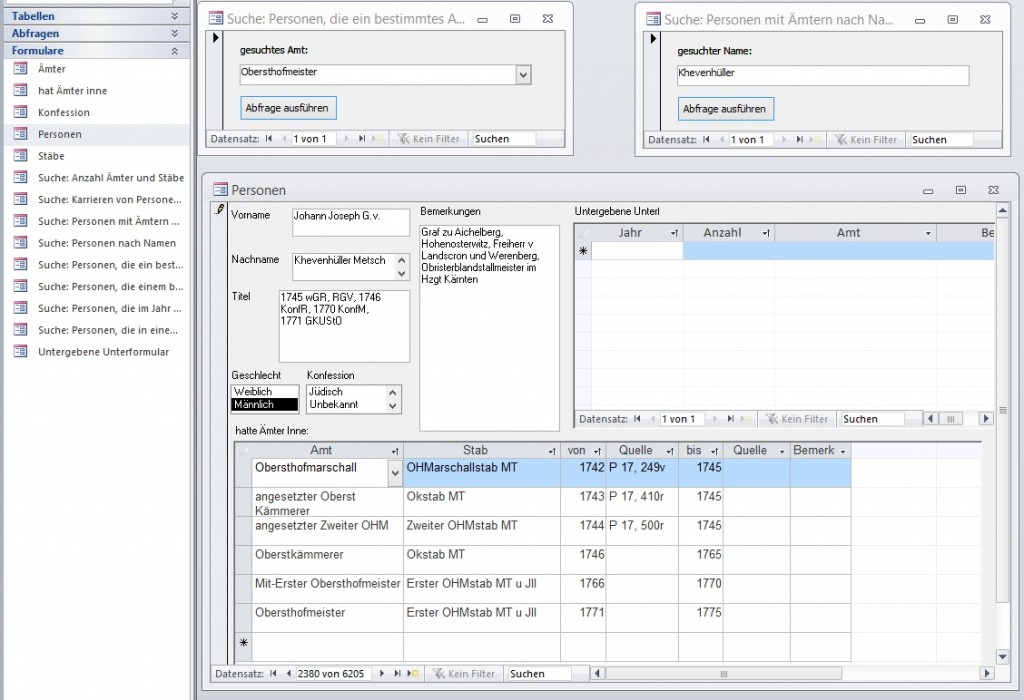The princely court of the Habsburg family in early modern Vienna was – as much for its size as its prestige – generally considered as one of the leading princely courts within the Holy Roman Empire. This distinguished position can be ascribed to the Habsburg dynasty as it combined the rule over the Holy Roman Empire, the Austrian Hereditary lands and the kingdoms of Hungary and Bohemia for most of the early modern age.
Their residence in Vienna served at the same time as the center of the political and military administration of their countries and as the household for the dynastic family. As such, the court of Vienna constituted an important meeting point for men and women from different social backgrounds. For all of them, the court of Vienna was a place where different “goods” such as jobs, financial support, old-age pensions, aristocratic and honorary titles, prestige and honor, but also contacts, influence and suitable marriage partners could be obtained. The possibility of benefitting from one of these “goods” made the court attractive for male and female petitioners, visitors and employees alike, may they be of noble birth or of more humble origins.
The princely court in early modern Vienna has recently attracted the interest of a growing number of historians and other researchers. While some aspects of the Viennese court have so far been studied in depth, our knowledge about its internal organisation and the processes of decision-making remains insufficient. Up until now, we don´t know much about the organisational principles at work behind the glamorous outward appearance of court life or the numerous staff that ensured the effectiveness of its day-to-day business. the need for further systematic and source-oriented studies is evident.
This research project, located at the University of Vienna and the Austrian Institute of Historical Research (Institut für Österreichische Geschichtsforschung) deals with this topic. The project aims to uncovering career patterns, showing the underlying hierarchical structures and revealing the processes of decision-making. In this context, the project will also look into the modes of the distribution of graces (jobs, titels, pensions).
Our sources
The Hof- und Ehrenkalender: These calenders were published once a year. Since 1715, they include every year a systematic list of the current court staff. This list ranges from the top-position of the (noble) Obersthofmeister (the high steward) to the numerous (mainly non-noble) household staff in the kitchens, chambers and stables. In the 18th century, the court staff amounted to roughly 1.500 to 2.300 people per year.
The Hofparteienprotokolle: They are handwritten supplication registers that assemble the administrative activities of the court in a chronological order, e.g. the hiring and promoting of the staff, payment issues or old-age pensions. They were managed by the office of the Obersthofmeister and served as reference books for internal purposes.
Together with other additional sources (supplications, job applications or testaments), they provide enough data for an in-depth study of the men and women working at court.
Most of our sources are mainly in German, rarely in French, Italian or Spanish. Most of them are preserved in the Haus-, Hof- und Staatsarchiv (HHStA, a department of the Österreichisches Staatsarchiv) in Vienna.
Our database
We collect the career data of the court staff members in a MS-Access Database. So far, we have the data of more than 6.000 people over almost a century (1711–1806).
Below, you can see the datasheet for Maria Theresias high steward, Fürst von Khevenhüller-Metsch. You can see the career steps he had to take before he acquired the top position at court, the office of high steward.
Since the Hofkalender for the years 1741 to 1744 are lost (or were never published), we had to fill this gap with the data provided by the Hofparteienprotokolle. This is why we wrote “P 17,…” in the space for “Quelle” (source). P 17 means that the data for this year was taken from the Hofparteienprotokoll volume 17. The number on the right from it is the folio (pagenumber).
For reasons of space, we had to use abbreviations for the different departments (Stäbe, like Obersthofmeisterstab, Oberstkämmererstab etc.) and the person they worked for (e.g. MT = Maria Theresia, J II = Joseph II). We also had to shorten aristocratic titles (in the field for “Namen” = names, e.g. Graf von… = G.v., meaning count of…), honorary titles (in the field for “Titel” = titles), some offices (in the field for “Amt” = office). Check this list for the abbreviations (english version is in progress)
About 10% of the court staff were women. Their offices were mainly in (but not limited to) the female entourage, e.g. as a lady-in-waiting, ladies maid, cook or laundress. In this project, we also want to make visible the part women played in the daily functioning of the court.
Our goals
- provide a source-based prosopographic study on the men and women working at the Viennese court in the 18th century.
- provide a study of the careers of the court staff, especially their “middle class” male and female members from their entry to their retirement.
- get a better knowledge of the basic parameters of their employment at court and their social and gender profile.

